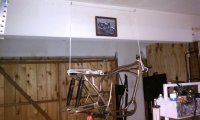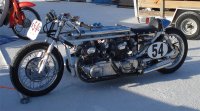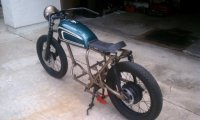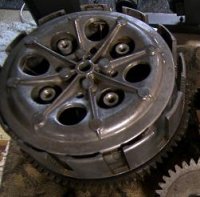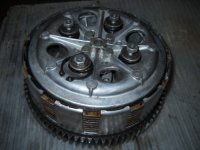I am more or less constantly amazed about how little knowledge this is about automotive type painting among motor-sport enthusiasts. Virtually all cars and bikes are painted, but no one seems to know squat about paint.
Rattle can paint is worthless for painting bikes or cars, in fact its worse than worthless because you have to go to the effort and expense of removing it after it fails or suffer a bike with greatly diminished value because of its rattle can paint job. The stuff is garbage designed to rope in the folks who think it will make their patio furniture look nice - another thing its not much good for. There is one exception to this, one that is little known and rarely used. Many paint suppliers can mix up a paint and put it in a rattle can for you, even a catalyzed paint (which must be used quickly). You're still stuck with no paint control because of the rattle-can's paint valve, but at least you can get decent paint put in the can.
Automotive paints come in many types and varieties, but for your purposes there are only a few. First there are "single stage" paints, which are paints that stand alone and provide their own color and gloss. Basically you shoot them on, in a couple of coats, and let it dry a day or two and its done. 2K paint systems, and by the way, the paints were developed in Germany and the "2K" stands for "two komponent", are paints in which a base coat carries the color and a clear coat provides the gloss and final protection. There are a lot of painters who swear by single stage paints. Their claim, and its is a good one, is that for single colors they are more color-fast, the colors are usually more vibrant. A lot of people also think that single stage blacks are the blackest of blacks. That said, virtually every custom paint job you see is done with either base coats followed by clear or with candies followed by clear, with the base or candy being either catalyzed or not, but always in a two (or more - often many more) stage process.
Clear coats are impervious to gasoline. Virtually all clear coats (not intercoat clears, which are an entirely different product) are catalyzed, which is to say they require a hardener to set up. They do not dry, they "set" by way of a chemical reaction between components of the clear itself and other components in the hardener.
About degreasers and degreasing; no one is talking about globs of grease like you'd find around a ball-joint, what degreasers do is remove the greases and oils from your hands and similar sources. All it takes to ruin a paint job is a finger-print's worth of oil. Degreasers themselves can be bought at your local automotive paint supplier, the PPG stuff I use cost right at $20 a gallon and is enough to do a half a dozen bikes. I use a water based degreaser but it also comes in solvent based. The trick with these cleaners is to remember that what they do is lift the contaminants and hold them in suspension long enough for you to wipe them off. You don't let your degreaser/wax-remover dry on the surface, you wipe it, and the contaminants it freed up, off the surface. Normally you degrease before you shoot your first coat of sealer on top of the metal before priming and won't use it again until after all the prep is done and you're ready to shoot your final sealer before painting.
As for powder coating, its probably the best way to finish a frame. It is much more durable than even the best base-coat/clear-coat job and costs about the same as top of the line paint products. The down side, which is becoming less of one every day, is that you don't have as many choices of color or effect as with paints - but that is changing very quickly. My local guy gets right at $200 to do a frame along with its assorted brackets, swing arm, and such. Naturally that includes prep (sand blasting) and masking.
As to brands, it depends on where you are and what's around. If you live in or near a good sized town there should be at least one auto paint supplier who carries a nationally known brand. If not you can mail order any paints or prep materials you need. TCP Global is the leading internet supplier of such things, they are reasonably priced and they have everything you need. If you are planning on using top of the line products be prepared for a little sticker shock. A problem for a guy wanting to paint a bike is that all the products he will need are sold in quantities much greater than he will need. The smallest amount of base coat you can usually buy is a quart, but a quart is enough base coat to paint a dozen motorcycles. 4 oz of mixed paint (base coat plus reducer) is more than enough to paint a motorcycle frame with several coats of paint. A quart of House of Kolor BC25, Black, will cost you about $45 plus shipping. Fortunately TCPGlobal sells their own lineup, hearalded by Ed Hubbs (look him up on You-Tube for his videos on custom painting, they are fantastic!) the stuff is called their Kustom Shop lineup. They sell Ready To Spray (RTS) basecoats in 4oz. containers. I think they get $10~15 for them, a great savings for the bike painter. The thing that lets me recommend them is that TCP has great product turnaround, nothing sits on the shelves for long. So you can buy pre-reduced paint from them and be confident that it hasn't been sitting in the bottle for a year or two before you got it. It should be fresh. Don't get me wrong, left-over base coat, even if it has been reduced, can be kept for a very long time; its just best if you don't. Sooner or later the pigments or dies form into little dust-like blobs in the carrier. You don't want that.
That's all that comes to mind immediately from the original question. Got any more questions?


